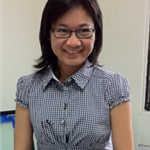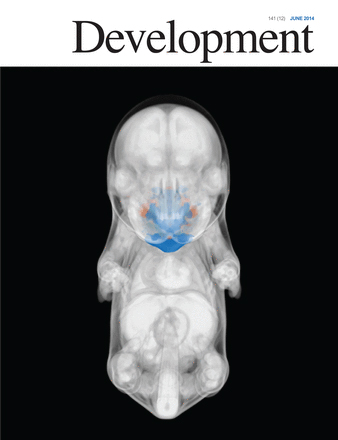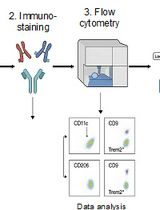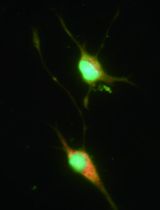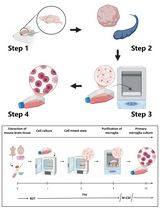- EN - English
- CN - 中文
Isolation of THY1+ Undifferentiated Spermatogonia from Mouse Postnatal Testes Using Magnetic-activated Cell Sorting (MACS)
采用免疫磁珠分选法(MACS)分离小鼠出生后睾丸中的THY1+未分化精原细胞
发布: 2016年12月20日第6卷第24期 DOI: 10.21769/BioProtoc.2072 浏览次数: 12070
评审: Jyotiska ChaudhuriShravani MukherjeeManuel SarmientoAnonymous reviewer(s)
Abstract
In mammals, homeostasis of many tissues rely on a subpopulation of cells, referred to as stem cells, to sustain an appropriate number of undifferentiated and differentiated cells. Spermatogonial stem cells (SSCs) provide the fundamental cellular source for spermatogenesis and are responsible for the lifelong maintenance of the germline pool in testes throughout the reproductive lifespan of males. To gain insight into germline stem cell biology and develop strategies for infertility treatment, several germ cell isolation methods have been reported in order to acquire good quality and quantity of undifferentiated spermatogonia. Among them, magnetic-activated cell sorting (MACS) is an efficient cell isolation method that requires less time and less initial cell numbers to obtain an enriched cell population using an antigen-antibody reaction. Thymus cell antigen 1 (THY1, CD90.2) is recognized as a surface marker of undifferentiated spermatogonia in mouse neonatal and adult testes. Here, we describe a protocol for the isolation of one-week-old THY1+ cells and four-week-old THY1+ cells from mouse testes. The isolation procedure consists of three steps: testis collection and single cell suspension, cell labeling using a biotin-conjugated anti-THY1 antibody and magnetic cell separation. Note, this isolation protocol should be completed within five hours to maximize the quality and the amount of living cells.
Keywords: Testis (睾丸)Background
Co-existence of active and quiescent stem cells is observed in several adult tissues. Adequate balance between quiescence, self-renewal and differentiation is necessary to sustain an appropriate number of undifferentiated stem cells and to avoid premature stem cell exhaustion for the homeostasis of many tissues (Tseng et al., 2015; Wabik and Jones, 2015; Xin et al., 2016). Infertility has become an increasing problem for human couples and a significant portion of male-related infertility cases results from impaired undifferentiated spermatogonia (Boivin et al., 2007; Matzuk and Lamb, 2008). For this reason, SSCs in spermatogenesis, which is a well-characterized stem cell-dependent process (Oatley and Brinster, 2008), is a valuable model to study regulation of tissue homeostasis. Numerous studies have developed germ cell isolation methods in order to gain insight into the biological functions and regulatory networks of undifferentiated spermatogonia. However, in vivo undifferentiated spermatogonia are heterogeneous in their expression of markers including GFRA1, ID4, PLZF and THY1, and different experimental protocols have influences on the enrichment of subpopulations in specific cellular states (Buageaw et al., 2005; Chan et al., 2014; Costoya et al., 2004; Gassei and Orwig, 2013; Hermann et al., 2015; Kubota et al., 2003; Liao et al., 2014). For instance, a large proportion of PLZF+ and THY1+ undifferentiated spermatogonia is found in quiescent phase of the cell cycle in vivo, whereas PLZF+ and THY1+ undifferentiated spermatogonia cultured in mediums supplemented with serum and growth factors are inclined to the proliferation phase (Costoya et al., 2004; Kanatsu-Shinohara et al., 2011; Kubota et al., 2004a; Liao et al., 2014; Sada et al., 2009).
Here, we provide a step-by-step procedure for the isolation of relative quiescent THY1+ undifferentiated spermatogonia from pre-pubertal mice through a serum-free protocol using magnetic-activated cell sorting. This protocol also contains several important information, including cell numbers needed at each step for suitable enzymatic procedures for living germ cell isolation. This protocol should be a valuable tool to obtain large amount of high quality live undifferentiated spermatogonia with specific subpopulation enrichment through the use of antibodies against SSC surface antigens.
Materials and Reagents
- 100 mm Petri dish (Corning, Falcon®, catalog number: 351029 )
- Polypropylene tube:
2 ml tube (Corning, Axygen®, catalog number: MCT-200-C )
5 ml tube (Corning, Axygen®, catalog number: MCT-500-C ) - Centrifuge tubes:
15 ml tube (Corning, Falcon®, catalog number: 352096 )
50 ml tube (Corning, Falcon®, catalog number: 352070 ) - Cell strainer:
5 ml polystyrene tube with cell strainer snap cap (35 µm nylon mesh) (Corning, Falcon®, catalog number: 352235 )
70 µm nylon mesh (Corning, Falcon®, catalog number: 352350 ) - Columns for cell separation:
MS columns (Miltenyi Biotec, catalog number: 130-042-201 )
LS columns (Miltenyi Biotec, catalog number: 130-042-401 ) - Poly-L-Lysine coated slides (Thermo Fisher Scientific, catalog number: 10143265 )
- ARTTM Barrier Hinged Rack pipette tips
P1000 (Thermo Fisher Scientific, Thermo ScientificTM, catalog number: 2079-HR )
P200 (Thermo Fisher Scientific, Thermo ScientificTM, catalog number: 2069-05-HR )
P20 (Thermo Fisher Scientific, Thermo ScientificTM, catalog number: 2149-05-HR ) - C57BL/6N Mice (BioLASCO, catalog number: C57BL/6N )
- Hank’s balanced salt solution (HBSS), calcium, magnesium, no phenol red (Thermo Fisher Scientific, GibcoTM, catalog number: 14025092 )
- Hank’s balanced salt solution (HBSS), no calcium, no magnesium, no phenol red (Thermo Fisher Scientific, GibcoTM, catalog number: 14175095 )
- Type IV collagenase (Thermo Fisher Scientific, GibcoTM, catalog number: 17104019 )
- DNase I (RNase-free) (New England Biolabs, catalog number: M0303 )
- Antibodies:
Biotin rat anti-mouse CD90.2 (Clone 30-H12) (BD, catalog number: 553011 )
Biotin rat IgG2b, κ isotype control (Clone A95-1) (BD, catalog number: 553987 )
Anti-CD90.2Biotin antibody (Lot 5150211128) (Miltenyi Biotec, catalog number: 130-101-908 )
Anti-CD49f antibody (BD, catalog number: 551129 )
Isotype antibody (negative control) (BD, catalog number: 551066 )
Anti-PLZF antibody (Santa Cruz Biotechnology, catalog number: sc-28319 )
Anti-VASA antibody (Abcam, catalog number: ab13840 )
AffiniPure Donkey Anti-Rabbit IgG (H+L) (Alexa Fluor® 488) (Jackson ImmunoResearch, catalog number: 711-545-152 )
AffiniPure Donkey Anti-Mouse IgG (H+L) (Alexa Fluor® 488) (Jackson ImmunoResearch, catalog number: 715-545-151 ) - Anti-biotin microbeads (Miltenyi Biotec, catalog number: 130-090-485 )
- PFA (Sigma-Aldrich, catalog number: 158127 )
- Bovine serum albumin (BSA), IgG-free and protease-free (Jackson ImmunoResearch, catalog number: 001-000-162 )
- Normal donkey serum (Abcam, catalog number: ab7475 )
- EDTA, 0.5 M, pH 8.0 (Thermo Fisher Scientific, AnbionTM, catalog number: AM9260G )
- BSA
- Dulbecco’s phosphate-buffered saline (DPBS), no calcium, no magnesium (Thermo Fisher Scientific, GibcoTM, catalog number: 14190144 )
- Trypsin-EDTA, 0.25%, phenol red (Thermo Fisher Scientific, GibcoTM, catalog number: 25200056 )
- Fetal bovine serum (FBS) (Thermo Fisher Scientific, GibcoTM, catalog number: 16000044 )
- PE-Cy5-conjugated antibody
- Tween-20 (Sigma-Aldrich, catalog number: P9416 )
- E-HBSS (see Recipes)
- MACS buffer (see Recipes)
- Collagenase solution (see Recipes)
- Trypsin solution (see Recipes)
- F-MACS buffer (see Recipes)
- Staining buffer (see Recipes)
- FACS buffer (see Recipes)
- PBST (see Recipes)
Equipment
- Sterilized forceps and scissors
- Dissecting microscope (Leica MZ16F Stereomicroscope)
- P1000 pipette
- Centrifuge
- Hemocytometer
- Magnetic separator
OctoMACSTM separator for MS columns (Miltenyi Biotec, catalog number: 130-042-109 )
MidiMACSTM separator for LS columns (Miltenyi Biotec, catalog number: 130-042-302 ) - Beckman Coulter FC500 cytometer (Beckman Coulter, model: FC500 )
- Leica TCS SP5 II confocal microscope (Leica Microsystems, model: Leica TCS SP5 II )
Procedure
文章信息
版权信息
© 2016 The Authors; exclusive licensee Bio-protocol LLC.
如何引用
Liao, H., Kuo, J., Lin, H. and Lin, S. (2016). Isolation of THY1+ Undifferentiated Spermatogonia from Mouse Postnatal Testes Using Magnetic-activated Cell Sorting (MACS). Bio-protocol 6(24): e2072. DOI: 10.21769/BioProtoc.2072.
分类
细胞生物学 > 细胞分离和培养 > 细胞分离
细胞生物学 > 细胞成像 > 共聚焦显微镜
您对这篇实验方法有问题吗?
在此处发布您的问题,我们将邀请本文作者来回答。同时,我们会将您的问题发布到Bio-protocol Exchange,以便寻求社区成员的帮助。
Share
Bluesky
X
Copy link




